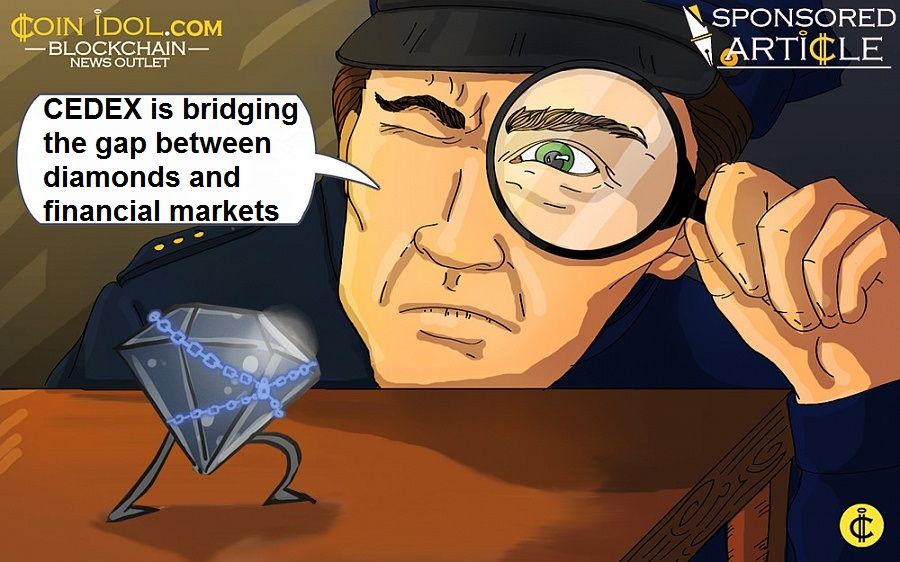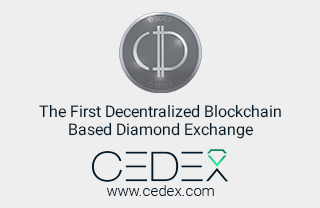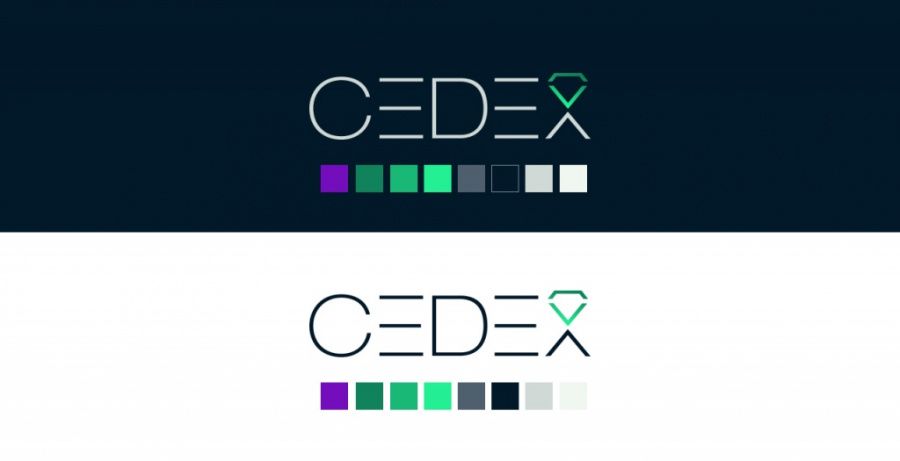How CEDEX is Bridging the Gap Between Diamonds and Financial Markets with an Industry-First Solution

A beautifully polished, sparkling diamond can represent many things. Elegance, class, sophistication, value and even love.
But what if someone told you it can also represent financial stability and that this is probably the precious stone’s most notable characteristic.
You see, most of us grow up believing that diamonds only have a single function, and that is to be presented in an item of jewelry. And although a piece of diamond jewelry can be spectacular, it is also an asset that has the potential of being leveraged for financial gain.
The problem is that 99.9% of us are not diamond experts and you can’t just do a Google search to get the value of a diamond.
This is where CEDEX comes in.
CEDEX is an accessible diamond exchange and trading platform based on Blockchain technology. The first of its kind, their overall objective is to bridge the gap between financial markets and the traditional diamond industry.
Having expert industry knowledge, the CEDEX team hopes to empower individuals to trade and invest in diamonds in an easy and straightforward process, just like you would with more conventional asset classes.
To do this they provide three financial offerings, catering to a broad range of customers with individual needs.
These financial offerings include:
· The option of selling or trading in single diamonds with smaller values.
· For particularly high-value stones, there’s the option of a shared investment (like owning stock in a company).
· And then there’s the basket option that takes multiple diamonds and groups them together to sell to multiple traders (also called a Diamond ETF).
At the center of this innovative platform is the company’s proprietary machine-learning algorithm, simply called The DEX.
What is the DEX?
The DEX was borne out of the need to overcome one of the industries biggest challenges when attempting to classify diamonds into a particular asset class, and that is the lack of transparency and continuity in diamond appraisal processes.
The average person that owns a diamond will find it very difficult to ascertain the true market value of their stone. You could, of course, speak to an appraiser but you then have to rely entirely on their word.
What’s worse is that different appraisers will probably give you different valuations.
And that’s the problem of continuity within the industry.
One carat can be assigned a different value in different diamonds, depending on a combination of the cut, clarity and color.
We know what an ounce of gold costs, a gallon of crude oil, even a gram of saffron or white truffles.
Diamonds are one of the most precious commodities on earth, yet its unique pricing dependencies create a lack of value standardization on the open market.
This is what the DEX is looking to bring to the industry: enabling the standardization of diamond pricing through a transparent process and thereby providing that missing link which makes it easier for everybody (not just experts) to buy, sell or trade diamonds.
How Does The DEX Work?
The DEX algorithm is based on a form artificial intelligence called machine learning.
According to Expert System, machine learning is “an application of artificial intelligence (AI) that provides systems the ability to automatically learn and improve from experience without being explicitly programmed” and “focuses on the development of computer programs that can access data and use it learn for themselves.”
The idea is to give computer software access to a dataset and it will then ‘learn’ by applying statistical analysis to predict outcomes within acceptable ranges, without humans specifically programming it to do so.
In order for the DEX software to accurately rank individual diamonds according to its open market value, it relies on the input of three unique sets of data:
Gemological Composite: The gemological characteristics of a diamond are what most of us would know as the “4 C’s”, i.e. carat, cut, color and clarity. This is commonly used to grade diamonds and other gemstones. The grading system was developed by the Gemological Institute of America (GIA) and is one of the main indicators of the value of a stone. Usually stated as a percentage, it basically tells you the level of perfection of a particular diamond.
Parallel Trades: The parallel composite of a diamond indicates how rare a specific diamond or diamond category is and also states the number of diamonds included within the specific category.
Diamond Indices: A diamond index can give potential traders a general idea of the value of a particular stone in existing markets, i.e. how much it would sell for under current demand.
The DEX uses this information not just to give an accurate market price of a diamond but also to quantify this value by ranking diamonds according to this price, so users can clearly understand how this compares to other diamonds.
This means traders can trade with confidence on the CEDEX platform without being a diamond expert. They can make use of this analytical data that the DEX provides to make an informed decision based on the ranking of a diamond in a specific category, and easily pick out the stones that represent the best value for money.
Providing detailed analytical data on diamonds and arranging it in an easy to understand manner is a first for the industry and truly revolutionary. It opens up the diamond trading industry to a much wider demographic, including the average Joe on the street who’s a complete diamond novice.
There’s currently an Alpha version of the DEX available on CEDEX’s platform which will analyze 0.3, 0.5 and 1-carat diamonds. Developments are underway to add additional types of diamonds which will maximize the pricing of individual stones through the DEX algorithm. The end goal is to price any given certified diamond at a 99.5% accuracy rate.

Using DEX Data for Category Trading
The DEX solution will further assist traders with one of CEDEX’s financial offerings called Category Trading. In conjunction with the DEX algorithm, CEDEX leverages the capabilities of Blockchain technology to classify diamonds into certain categories, based on the gemological data of each stone.
As diamonds come in different shapes and sizes, the aim here is to create groups of homogenous products, something that’s notoriously difficult within the industry.
CEDEX will assign each category with a benchmark value. Once diamonds are uploaded onto the system and categorized, along with its price, each individual diamond will receive a deviation score from its relevant category benchmark.
This deviation score is encrypted within the Diamond Smart Contract (see below). This ability of the system to assign each diamond with a deviation score is a direct result of the unique capabilities of the DEX algorithm.
An autonomous smart contract will calculate the difference in value from the baseline category value while the DEX analyze and rate all Diamond-Smart Contracts in the same category, thereby creating a homogenous asset class for traders to work with.
So What is a Diamond Smart Contract?
Another important pillar of the CEDEX solution is a process called diamond tokenization.
Traditionally, it’s been near enough impossible for individual diamond holders to turn their diamonds into a liquid asset.
The CEDEX platform gives users the opportunity to do this through a straightforward and simple tokenization onboarding process in order to create a smart contract (self-executing contracts with the terms of the agreement between buyer and seller being directly pre-written into lines of code - Investopedia)
The Smart Contract then becomes the digital representation of the financial offering on the CEDEX network, which could be the sale of a single diamond, shared investment for higher value stones or a Dimond ETF (basket).
A custodian will take delivery of the actual diamond once a trade request is made. The diamond will be inspected and validated against an official GIA certificate.
When the diamond is approved and authenticated, a Diamond Smart Contract is created on the network which logs an immutable record, and sent to the owners’ digital wallet.
The owner now has two choices; they can either sell the Diamond Smart Contract peer-to-peer or list it on the CEDEX exchange. So in effect, the Diamond-Smart Contract becomes the tradable commodity backed by the actual diamond which, all the while, stays protected from theft, damage and manipulation with the secure custodian.
To ensure the integrity of the network and protects its users from counterfeit stone, traders will only be allowed to purchase diamonds that are backed by a GIA certificate over the CEDEX exchange.
Turning your diamond into a liquid asset can be done in three easy steps:
1. Upload your diamond’s GIA certificate
2. Indicate the number of Diamond Smart Contracts you want to create, depending on the CEDEX financial offering you want to use (i.e. diamond basket, shared investment or single stone)
3. Order a pickup of the diamond through the system and list the Diamond Smart Contract on the CEDEX exchange or sell peer-to-peer.
Conclusion
The diamond industry has, for many years, been constrained by several inherent challenges that prohibit it from reaching its full market potential.
As it currently stands, the diamond market is made up of 99% sales through high-street diamond jewelers and industrial trade, while only 1% is attributed to investment.
CEDEX, along with its industry-first DEX algorithm, is looking to completely turn this around by overcoming these inherent restrictions and making it easier for everyone to invest and trade their diamonds, not just a small percentage of experts.
This will benefit each and every single individual looking to make their personal diamond a more liquid commodity and also push the industry as a whole to reach its fullest economic potential.

Disclaimer. This article is paid and provided by a third-party source and should not be viewed as an endorsement by CoinIdol. Readers should do their own research before investing funds in any company. CoinIdol shall not be responsible or liable, directly or indirectly, for any damage or loss caused or alleged to be caused by or in connection with the use of or reliance on any such content, goods or services mentioned in this article.
Price
Price
News
Price
Price

(0 comments)